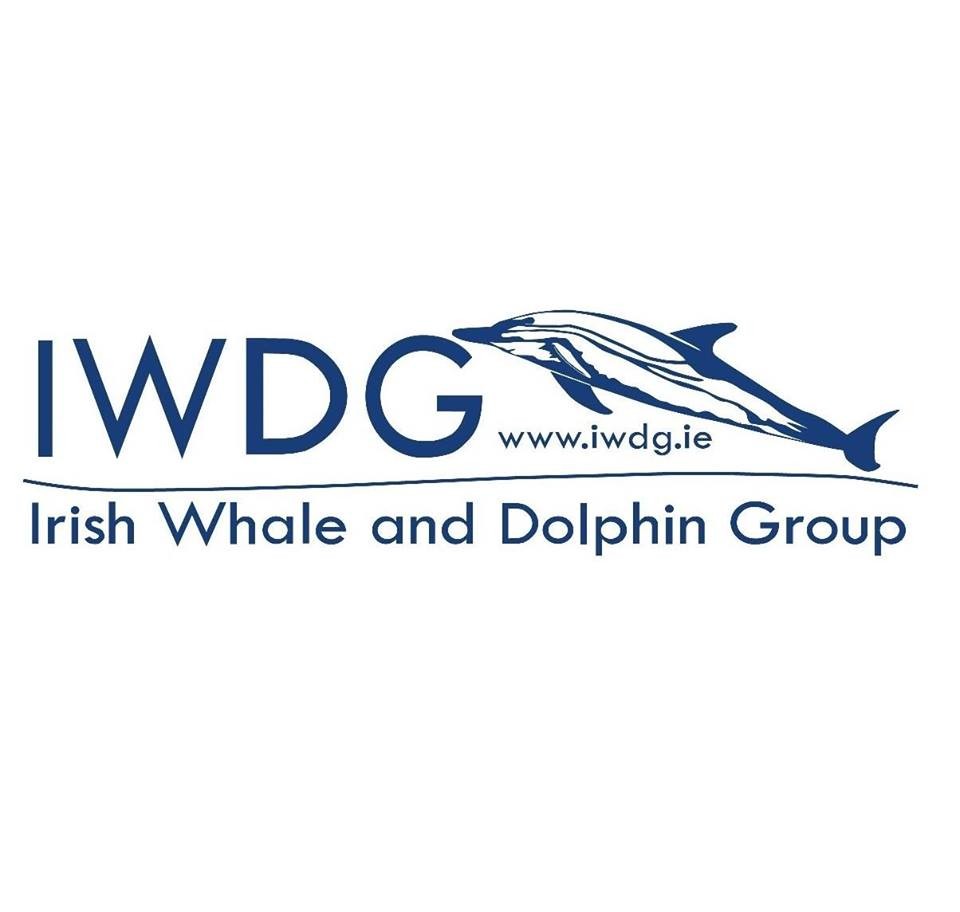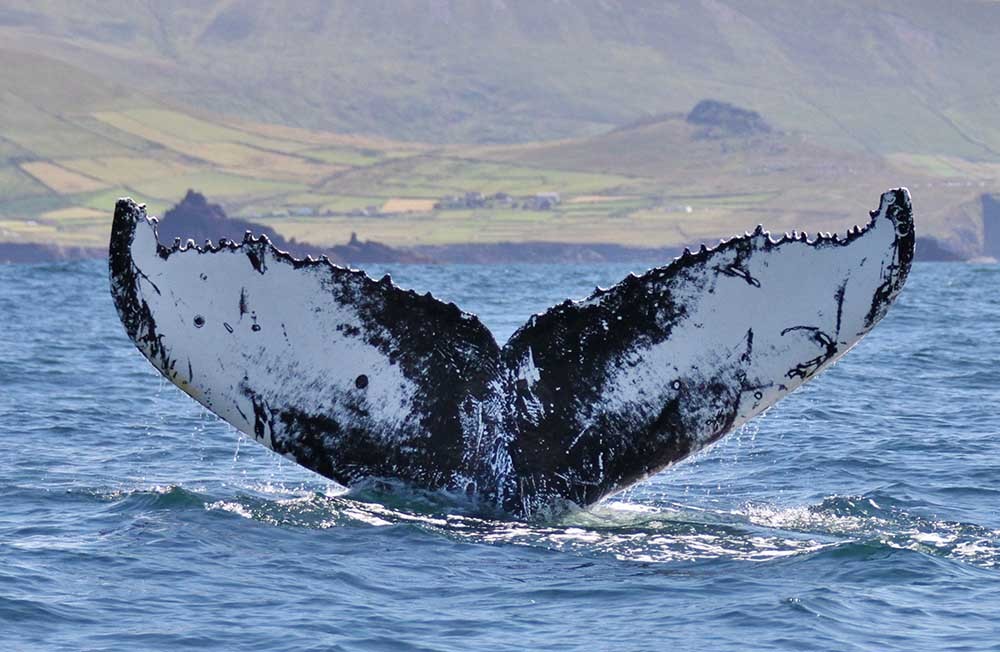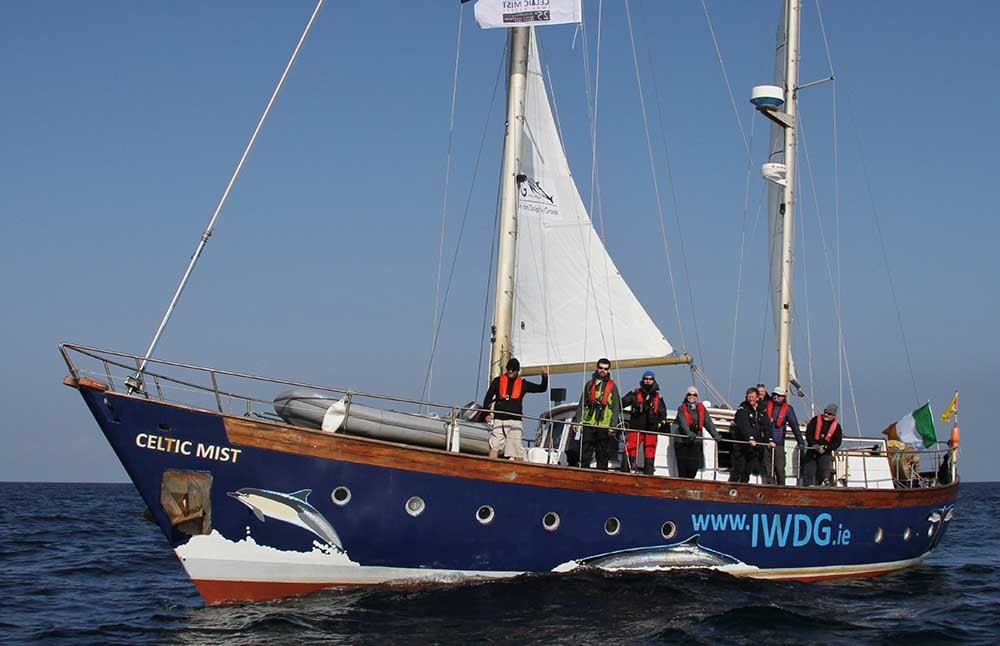
After 16 years of searching, the Irish Whale and Dolphin Group (IWDG) has located a breeding ground for humpback whales feeding in Irish waters.
Humpback whales undergo one of the longest annual migrations of any animal on the planet, travelling from rich feeding grounds at high latitudes, such as Ireland, to tropical breeding grounds near the equator. During a recent expedition to Cape Verde Islands off west Africa the Irish Whale and Dolphin Group photographed a humpback whale which had been seen 4 years previously off west Kerry. This is the first re-sighting of an individual humpback whale from Ireland to a known breeding ground, and for the first time locates a known breeding ground for humpback whales in Ireland.
Humpback whales have been increasing in number in inshore Irish waters since the IWDG first started documenting them through photo-identification in 1999. To date, 92 individual whales have been recorded from unique and permanent markings on their tail flukes and dorsal fins. Most (80%) of these individual whales have been recorded more than once in Irish waters with two-thirds recorded over five times and 14% recorded over ten times. One individual has been recorded in Ireland on 48 occasions. Many of these whales are returning each year. Over one-half have been recorded in more than one year, with 9% recorded in five years or more and one individual in 13 of the past 20 years.
These whales are not just passing through Irish waters but here for weeks and often months during spring, summer and autumn. The number of re-sightings of the same individual whales within a year ranges from 1 to 22 and residency times range between 2 and 168 days with an average of 39 days, that well over a month.

This research by the IWDG over the past 20 years has shown Ireland to be an increasingly important site for humpback whales. But until now we had never established where they breed. Over 16 years ago in 2003, the IWDG sailed to the Cape Verde Islands, an archipelago of 10 islands around 500km west of Senegal, just 1500km above the equator. We felt this was the most likely origin of humpback whales in Ireland but the Cape Verde humpback whale population is small (c.300 individuals) and has not recovered from years of whaling in the 18 and 19th centuries. Although we found humpback whales, none matched to those photographed in Ireland. We went back in 2006, and 2011 and 2012 and 2014. But no luck. Despite capturing images of over 100 individual humpback whales during these expeditions none of these whales had been seen in Ireland.
But on a chance excursion to Santa Monica off the southwest tip of Boavista during a two week expedition to Sal Rei on Boavista in April 2019, we struck lucky. Two whales surfaced near the research boat towards the end of the day trip. Both whales were photographed by Simon Berrow and one of these whales was the same individual photographed off west Kerry in 2015 by Nick Massett.
Nick Massett of Ventry, Co Kerry, who photographed the humpback whale off the Blasket Islands in 2015 said “what a fantastic outcome for the IWDG. It was born out of the belief that the Cape Verde Islands was the breeding ground for the humpbacks we have documented here off Ireland. But it is down to the dogged persistence of the expedition teams that have returned there over the years to prove the theory. I am delighted for Simon Berrow that he finally got the definitive proof of this connection, and pleased to have played my part in documenting the animal here off County Kerry.”

IWDG Sightings Officer Pádraig Whooley, who manages the Irish Humpback Whale Catalogue on behalf of the IWDG, reflected that “after almost 1,000 validated Irish humpback sighting records and 100’s of encounters over several decades, resulting in thousands of images being shared with colleagues throughout the North Atlantic, we’ve finally found a really important missing piece of the jigsaw; but it’s a very large puzzle, which still has lots of missing pieces”. With this important discovery, we now know we are on the right track to solving one of the biggest mysteries in Irish natural history.
Dr Simon Berrow, CEO of the Irish Whale and Dolphin Group and discover of this important find says “it comes as a relief that we finally find at least one breeding ground for Irish humpback whales, it also raises issues regarding how is Ireland going to use this important finding to enhance the conservation status of this endangered humpback whale population. Those responsible for marine conservation in Ireland will have to build relationships with, and provide assistance to, the Cape Verde government in their efforts to protect this critically important breeding ground”.
The IWDG are planning another expedition to Cape Verde in September to explore the waters around Cape Verde and train up local biologists in survey techniques and species recording.
